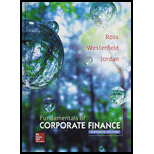
Calculating Interest Kates [LO3] Solve for the unknown interest rate in each of the following:
![Chapter 5, Problem 4QP, Calculating Interest Kates [LO3] Solve for the unknown interest rate in each of the following:](http://dev-ingestion-image-output.s3-website-us-east-1.amazonaws.com/9780077861704/Chapter-5/images/61704-5-4qp-question-digital_image_001.png)
To calculate: The rate of return
Introduction:
Rate of return refers to the gain or loss on the investment. It also refers to the increase or decrease in the capital value of an investment.
Answer to Problem 4QP
The rate of return is as follows:
| Particulars | Present value | Years | Interest Rate | Future value |
| Investment A | $181 | 4 | 13.18% | $297 |
| Investment B | $335 | 18 | 6.72% | $1,080 |
| Investment C | $48,000 | 19 | 7.37% | $185,382 |
| Investment D | $40,353 | 25 | 10.86% | $531,618 |
Explanation of Solution
Given information:
Investment A has a present value of $181, future value of $297, and a 4-year investment period. Investment B has a present value of $335, future value of $1,080, and an 18-year investment period.
Investment C has a present value of $48,000, future value of $185,382, and a 19-year investment period. Investment D has a present value of $40,353, future value of $531,618, and a 25-year investment period.
The formula to calculate the rate of return:
Where,
“P” refers to the principal amount invested
“r” refers to the rate of interest or return
“t” refers to the number of years or periods of investment
“FV” refers to the future value or the current market value
Compute the rate of return of Investment A:
Hence, the rate of return of Investment A is 13.18%.
Compute the rate of return of Investment B:
Hence, the rate of return Investment B is 6.72%.
Compute the rate of return of Investment C:
Hence, the rate of return Investment C is 7.37%.
Compute the rate of return of Investment D:
Hence, the rate of return Investment D is 10.86%.
Want to see more full solutions like this?
Chapter 5 Solutions
Fundamentals of Corporate Finance with Connect Access Card
- I need help with this situation and financial accounting questionarrow_forwardRemaining Time: 50 minutes, 26 seconds. * Question Completion Status: A Moving to the next question prevents changes to this answer. Question 9 Question 9 of 20 5 points Save Answer A currency speculator wants to speculate on the future movements of the €. The speculator expects the € to appreciate in the near future and decides to concentrate on the nearby contract. The broker requires a 2% Initial Margin (IM) and the Maintenance Margin (MM) is 75% of IM. Following € Futures quotes are currently available from the Chicago Mercantile Exchange (CME). Euro (CME)- €125,000; $/€ Open High Low Settle Change Open Interest June 1.2216 1.2276 1.2175 1.2259 -0.0018 Sept 1.2229 1.2288 1.2189 1.2269 0.0018 255,420 19,335 In addition to the information provided above, consider the following CME quotes that are available at the end of day one's trading: Euro (CME) - €125,000; $/€ Open High Low June 1.2216 Sept 1.2229 1.2276 1.2288 Settle Change Open Interest 1.2175 1.2176 -0.0083 255,420 1.2189…arrow_forwardI need help with this problem and financial accounting questionarrow_forward
 Pfin (with Mindtap, 1 Term Printed Access Card) (...FinanceISBN:9780357033609Author:Randall Billingsley, Lawrence J. Gitman, Michael D. JoehnkPublisher:Cengage Learning
Pfin (with Mindtap, 1 Term Printed Access Card) (...FinanceISBN:9780357033609Author:Randall Billingsley, Lawrence J. Gitman, Michael D. JoehnkPublisher:Cengage Learning
